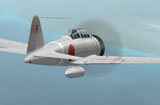 One
of my favorite childhood television memories has to do with a show about a flying
roughneck named “Pappy” Boyington and his motley band of Corsair drivin’
misfits. The show was called Baa Baa Blacksheep, and on the nights that I was allowed to
stay up late enough to watch it, it thrilled me with what I am now sure were the Hollywood
versions of the adventures of Boyington and his USMC Squadron’s half-comic t run-ins
with wily Japanese Fighters and overbearing military bureaucrats. Yep, if the Blacksheep
weren’t knocking those Zero’s out of the sky left and right, then they were in
the brig after an all night binge that ended with them bloodying the noses of their Navy
compatriots. Happily, with Microsoft’s Combat Flight Simulator II: WWII Pacific
Theater I can finally live out some of those adventures . . . well, the flying parts
anyways. One
of my favorite childhood television memories has to do with a show about a flying
roughneck named “Pappy” Boyington and his motley band of Corsair drivin’
misfits. The show was called Baa Baa Blacksheep, and on the nights that I was allowed to
stay up late enough to watch it, it thrilled me with what I am now sure were the Hollywood
versions of the adventures of Boyington and his USMC Squadron’s half-comic t run-ins
with wily Japanese Fighters and overbearing military bureaucrats. Yep, if the Blacksheep
weren’t knocking those Zero’s out of the sky left and right, then they were in
the brig after an all night binge that ended with them bloodying the noses of their Navy
compatriots. Happily, with Microsoft’s Combat Flight Simulator II: WWII Pacific
Theater I can finally live out some of those adventures . . . well, the flying parts
anyways.
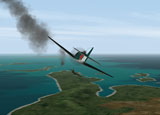 To start off abruptly (lets get to the nitty-gritty), many
features of the previous Combat Flight Simulator
installment have been greatly improved this time around. For instance, the enemy AI no
longer has planes diving into the ground at random intervals. On top of that, the
selection of player aircraft actually offers a more unique dogfighting experience due to
the aircraft’s differences and more accurate flight characteristic modeling.
Therefore pilots need to learn and apply strategies that take advantage of these
differences (more about this later). The damage model has improved as well, both for
the aircraft that you happen to be flying at the time and the aircraft you happen to be
filling full of bullets. A good part of the damage model can be deciphered through the
smoke that an injured aircraft is producing, i.e. white smoke denotes damage to coolant or
fuel systems, black smoke denotes burning oil or damage to the engine, and so on. All of
the aforementioned improvements add up to a far more realistic and challenging flight
combat experience. To start off abruptly (lets get to the nitty-gritty), many
features of the previous Combat Flight Simulator
installment have been greatly improved this time around. For instance, the enemy AI no
longer has planes diving into the ground at random intervals. On top of that, the
selection of player aircraft actually offers a more unique dogfighting experience due to
the aircraft’s differences and more accurate flight characteristic modeling.
Therefore pilots need to learn and apply strategies that take advantage of these
differences (more about this later). The damage model has improved as well, both for
the aircraft that you happen to be flying at the time and the aircraft you happen to be
filling full of bullets. A good part of the damage model can be deciphered through the
smoke that an injured aircraft is producing, i.e. white smoke denotes damage to coolant or
fuel systems, black smoke denotes burning oil or damage to the engine, and so on. All of
the aforementioned improvements add up to a far more realistic and challenging flight
combat experience.
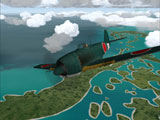 Player aircraft for the U.S. consist
of the Grumman F4F-4 Wildcat and F6F-3 Hellcat, Lockheed P-38 Lightning, and my all time
favorite, the Vought F4U-1A Corsair. Japanese aircraft at your disposal are the Mitsubishi
A6M2 Reisen and A6M5 Reisen, both generally known as the formidable Zero, and the
Kawanishi N1K2-J Shinden, also known as the George. The latter was the late war Japanese
answer to the US’s generally sturdier, faster, more heavily armed aircraft. Each of
these planes offers a wealth of sim flying experience with great looking cockpits and
exceptionally modeled characteristics. Player aircraft for the U.S. consist
of the Grumman F4F-4 Wildcat and F6F-3 Hellcat, Lockheed P-38 Lightning, and my all time
favorite, the Vought F4U-1A Corsair. Japanese aircraft at your disposal are the Mitsubishi
A6M2 Reisen and A6M5 Reisen, both generally known as the formidable Zero, and the
Kawanishi N1K2-J Shinden, also known as the George. The latter was the late war Japanese
answer to the US’s generally sturdier, faster, more heavily armed aircraft. Each of
these planes offers a wealth of sim flying experience with great looking cockpits and
exceptionally modeled characteristics.
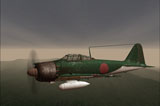 Let's talk about these
characteristics. Anyone that has been around a Corsair knows that it is a very big plane,
almost dwarfing its European contemporary the P-51 Mustang when sitting side to side. But
what the Corsair lacked due to its its large size, specifically maneuverability and
finesse, it more than made up for in speed and brute force. Coming out on top after
tangling with a Zero takes a little more than luck when flying the Corsair; the pilot must
learn to use the Corsair’s apparent faults, namely its size and weight, when taking
on the smaller, lighter, more agile Japanese foes. One of the best ways to turn the tables
is by always attacking from a higher altitude, using speed to catch the slower enemies by
surprise and using the Corsair’s massive guns to rip the shreds out unsuspecting
foes. Keep in mind that there is a big
difference in the difficulties settings, easy is really easy and realistic is really hard,
so you might want to get used to the planes before pulling out all the stops. Let's talk about these
characteristics. Anyone that has been around a Corsair knows that it is a very big plane,
almost dwarfing its European contemporary the P-51 Mustang when sitting side to side. But
what the Corsair lacked due to its its large size, specifically maneuverability and
finesse, it more than made up for in speed and brute force. Coming out on top after
tangling with a Zero takes a little more than luck when flying the Corsair; the pilot must
learn to use the Corsair’s apparent faults, namely its size and weight, when taking
on the smaller, lighter, more agile Japanese foes. One of the best ways to turn the tables
is by always attacking from a higher altitude, using speed to catch the slower enemies by
surprise and using the Corsair’s massive guns to rip the shreds out unsuspecting
foes. Keep in mind that there is a big
difference in the difficulties settings, easy is really easy and realistic is really hard,
so you might want to get used to the planes before pulling out all the stops.
The campaigns in CFS II
feature the definitive WWII battles at Wake Island, the Marshall and Gilbert Islands, the
Coral Sea, Midway and the Solomons. All of
these show-downs were won almost entirely with aerial might, so it is fitting that you can
fly into the fray to do your part, whichever side you choose.
However limited the terrain
featured in this game is-it’s mostly water-it’s an improvement over CFS I and,
actually, Combat Flight Simulator 2000 as well, although it maybe the fact that CFS2 runs
a whole lot smother and load times are much more bearable than CFS 2000's that makes me
think this. One great graphical improvement is the aircraft modeling, which is some of the
best yet in the entire flight sim genre. And weather effects are new to the CFS series,
and present some unique situations. Among my complaints, which are relatively few, is the
low level sensation of speed, which is not very impressive.
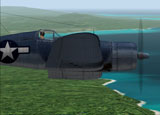 I’ve heard a lot of complaints
about CFS II’s “ugly” interface, but I actually dig it. The whole Pulp War
Comic thing comes of really well and tends to lighten up viciousness of WWII’s Pacific theater. This may have been a conscious
moral decision by Microsoft, and then it may not have been. I’ve heard a lot of complaints
about CFS II’s “ugly” interface, but I actually dig it. The whole Pulp War
Comic thing comes of really well and tends to lighten up viciousness of WWII’s Pacific theater. This may have been a conscious
moral decision by Microsoft, and then it may not have been.
CFS II comes packin’ a
300 plus page manual; it may take more time to read that puppy than it will to finish the
game. That brings me to replayability, which for flight sims is hard to distinguish from
playability. After all, playing the campaign comes low on the pilot’s checklist for
some flight simmers who are just out to see what a Corsair or Zero flies like. I often
fall into this group. Sometimes I just feel like going out and doing some touch-and-go’s,
or cruising around the patch doing a loop here and a roll over there. This is the essence
of flying, and why some of us pick up flight simulators in the first place-to fly to
planes that we will never get the chance to in real life. Fortunately, CFS II shines here.
Combat Fight Simulator II offers up a number of core improvements, new features and
an over all polish that makes it a worthy sequel to, and improvement upon, one of my
favorite flight simulators.
Thomas
Hoff |
